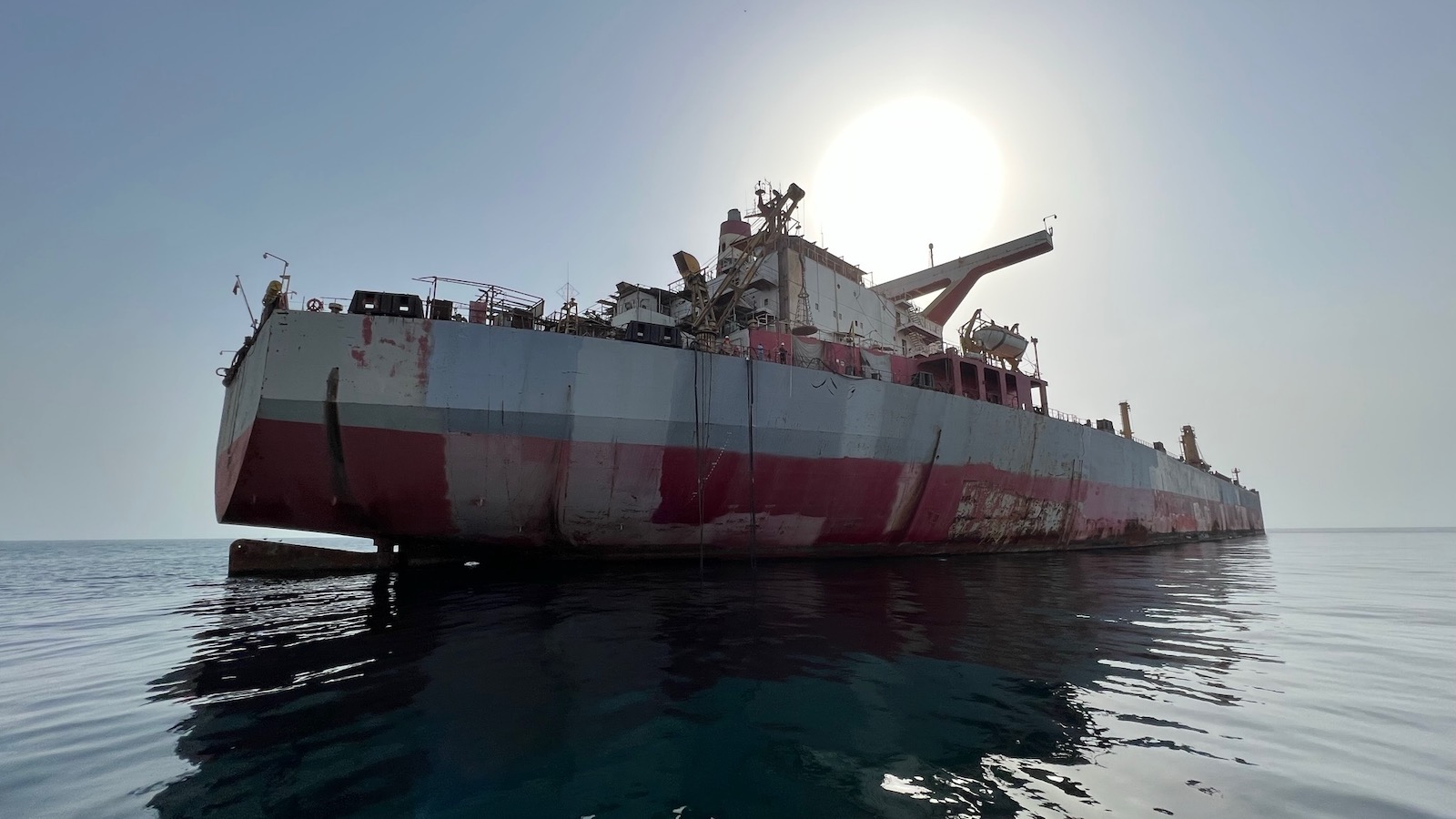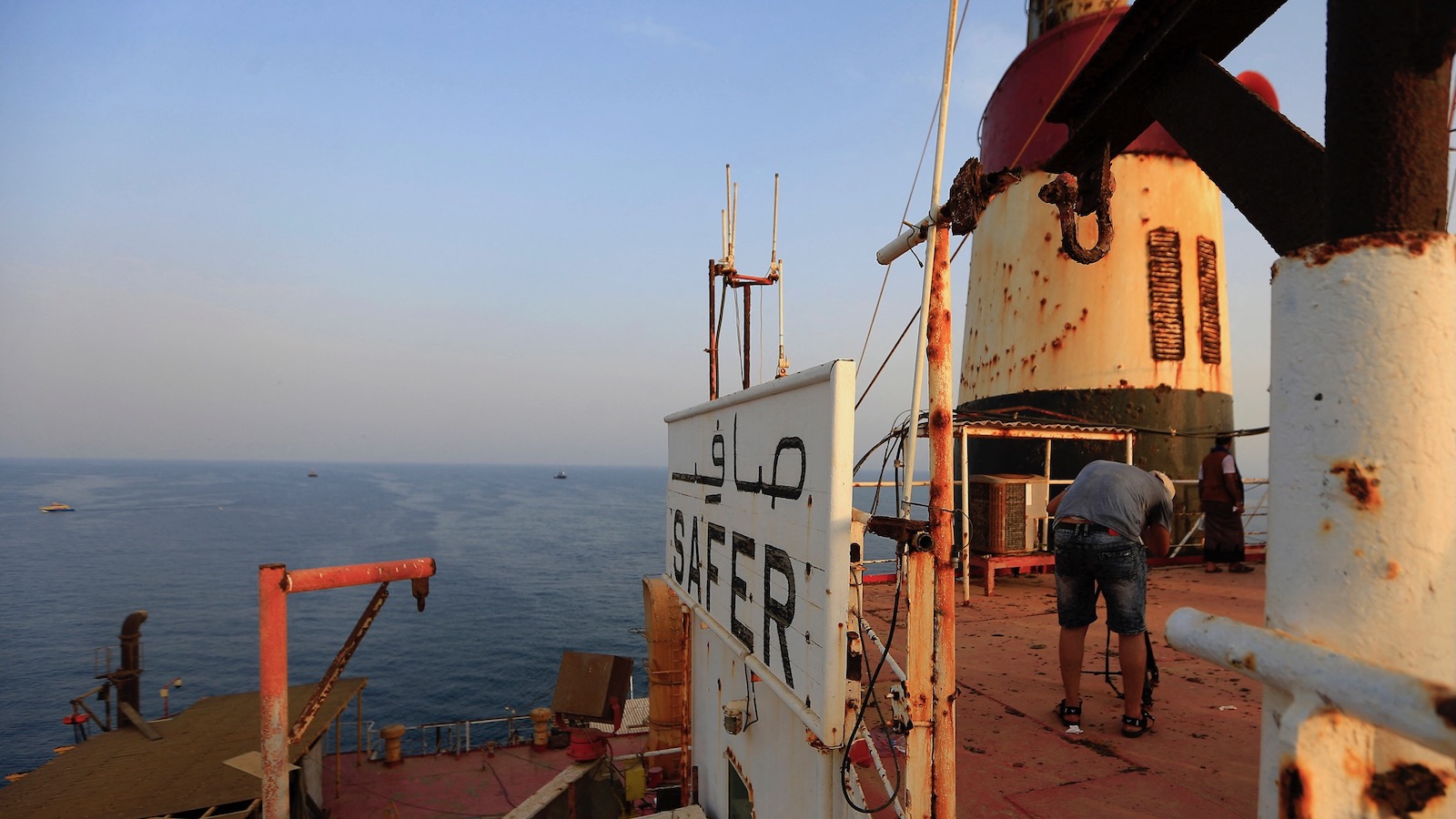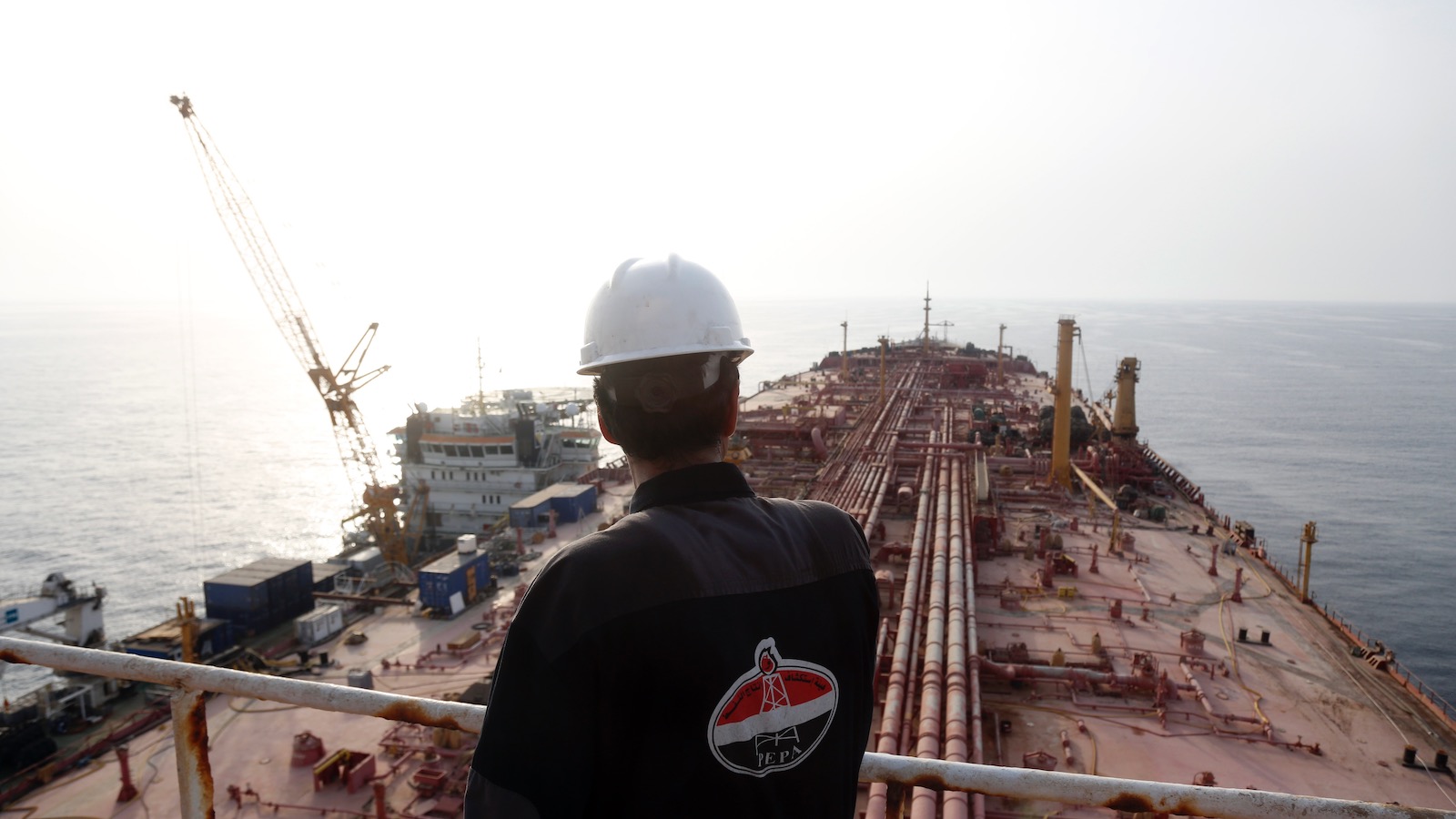
Ten days ago, the crew of a ship called the Nautica lifted anchor in Djibouti and motored north in the Red Sea. Two tugboats met the vessel about five and a half miles off the coast of Yemen, then guided it into place alongside the FSO Safer, a crumbling, abandoned oil tanker thought to hold 1 million barrels of crude.
Thus began an operation that’s the ecological equivalent of placing the pin back into a hand grenade.
Since 2019, the United Nations has likened the Safer (pronounced “suffer”) to a floating time bomb, one that could, through accident, structural failure, or attack, spill its cargo at any moment. That could release up to four times the oil spilled in the Exxon Valdez disaster, fouling the Red Sea for decades, if not centuries. Despite posing so great a risk for almost a decade, a vicious war in Yemen left the Safer beyond reach until May, when a U.N.-hired crew was allowed aboard to take the first steps in an emergency operation that could begin as early as today: transferring the oil to the Nautica, banishing the Safer to a scrapyard, and leaving the Nautica in its place.
Just getting this far is a diplomatic triumph for the U.N. Where others failed, it convinced the warring parties — particularly Houthi insurgents, who control the area around the Safer — that preventing an environmental and economic catastrophe was in their best interest. But some see this mission in a less flattering light: Even if all goes to plan — and in Yemen, that’s always an “if” — it will still leave a million barrels of oil floating in a conflict zone.
That left one Yemeni oil executive with state company SEPOC, which legally owns the Safer, grousing that the U.N. merely traded one time bomb for another. Sir Alan Duncan, a former British special envoy to Yemen who’s had a long career in the petroleum business, was more charitable when he called the operation progress but noted that the Nautica could wind up in the same position 10 years from now.
“It’s as good a plan as [the U.N.] were allowed to deliver,” he told Grist. “It’s only half a solution, but it’s better than nothing.”

The FSO Safer was an oil tanker built for another age. In the late 1950s, the temporary closure of the Suez Canal, which had long constrained the size of such vessels due to its breadth, inspired shipbuilders to think bigger. Then in the 1970s, a spike in world oil prices drove demand for even bulkier tankers that could move more crude at lower cost. The Esso Japan, built in 1976, was one of a class of “ultra large” oil vessels built in response to these trends. At almost 1,200 feet long and 230 feet wide, it could carry as much as 3 million barrels — twice the capacity of the Exxon Valdez, built a decade later.
In 1987, after a number of oil finds increased Yemen’s crude output, the vessel got a new name and career. Outfitted with updated gear and rechristened the FSO Safer, it was moored in the Red Sea. A pipeline two feet in diameter linked it to oil fields almost 275 miles away. Under its new owners, the Yemeni government, it became a key economic asset, a floating bank that could transfer the nation’s crude to tankers still working the high seas.
But even in this role, the Safer had a best-by date. It was to be decommissioned in 2000, according to Ian Ralby, a maritime-security consultant with IR Consilium who has done extensive research on the ship. SEPOC, one of Yemen’s national petroleum companies, decided it could stay in operation, getting maintenance as needed. But as war broke out in 2014, a fanatical rebel group called the Houthis sacked the capital of Sana’a. They soon realized a strategic gift lay just offshore: the Safer, loaded with black gold.
As the war intensified, the Safer drifted into the shadows. In 2015, an international coalition led by Saudi Arabia and the United Arab Emirates began a blistering, occasionally horrific, air campaign in an effort to restore the former government. The Houthis, supported by Iranian arms, have largely held their ground, forcing peace talks with the Saudis. But the Yemeni people have paid dearly. At least 377,000 have died of war, famine, and disease. Today, some 17 million Yemenis remain food-insecure and heavily reliant on humanitarian aid brought through the Houthi-controlled port of Hodeida, about 30 miles from the Safer.
It was not until years after the war began that the first reports by international analysts picked up on Yemeni warnings of the looming disaster. Tankers, even stationary ones, require vigilant maintenance against corrosion by heat, humidity, and the salty ocean environment. These reports showed that the Safer, save for the efforts of a small crew keeping the ship on life support, was not getting it.
This posed two critical risks. On a functioning oil tanker, inert gasses are periodically pumped into its tanks to keep the payload from catching fire or exploding. The Safer’s systems were kaput. Such ships also have the integrity of their hulls regularly checked. The Safer was last checked in 2015, a particular concern because unlike modern tankers, it has only one hull between its cargo and the sea. The combination of these factors meant the Safer could, with no notice whatsoever, crack like a walnut or erupt at the slightest spark.
“When you learn about it you think ‘holy s—,’” said Paul Horsman, an oil spill specialist with Greenpeace. “Why has this been left so long?”
A spill would cause breathtaking damage to Red Sea communities and the environment. According to U.N. estimates, in Yemen alone it would devastate the livelihoods of 2 million workers and family members dependent upon the fishing industry. Beyond sowing chaos in the aquatic food chain and casting toxic fumes over Yemeni farmland, it could poison Red Sea coral reefs currently under study for their resilience to ocean warming.
The cleanup, ballparked at $20 billion, would be daunting. The chemistry of Yemeni light crude makes it prone to mix with seawater, rather than float on top of it, and disperse over large areas. By the time crews arrived, said Chris Reddy, a senior scientist at the Woods Hole Oceanographic Institution, they might not even know where to start.

As it turned out, the Houthis and their enemies understood the risk the FSO Safer posed. They just disagreed on what to do with the oil, and their mutual hatred left them in no rush to strike a deal. Far from an imminent disaster that threatened them both, both sides came to treat the Safer as a strategic “tool of war,” as Musaed Aklan, a senior researcher with the Sana’a Center for Strategic Studies, put it.
An initial proposal, allegedly floated by Saudi Arabia and UAE, was to empty the Safer, cart off its oil and have the decrepit ship decommissioned in Bahrain. The Houthis rejected this flatly. Their position was cynical, but clear: They demanded an arrangement under the U.N. that would let them sell the crude and use at least part of the proceeds to govern the parts of Yemen they controlled. (Just what that might yield remains an open question, because petroleum degrades over time and prices fluctuate. Estimates have ranged from $50 to $90 million, though a new inspection may show otherwise.)
The Houthis also stipulated that no one could touch the ship without a sale in place. To their mind, whatever happened next was on Saudi Arabia, UAE, and their Western backers. “We hold the countries of aggression responsible for any damage that may befall the marine or navigational environment,” a Houthi leader tweeted in April 2019.
U.N. negotiators begged them to at least allow a safety inspection. But the Houthis, fearing an inspection might be a prelude to taking the oil, waffled. Meanwhile, the war fell into a bitter deadlock. The Saudis, Emiratis, and Yemenis seemed to grow more disengaged from the Safer, experts said, less concerned with addressing the crisis than making sure the Houthis took the blame for it. “If it explodes, it’s not our fault,” a Yemeni official told the Sana’a Center in 2020.
“Neither of Yemen’s main warring parties act like they have the slightest responsibility for preventing the massive catastrophe that could befall their country and the region,” the Center wrote, calling the behavior “obscene.”
The absurdity of the situation was underscored in November 2020, when the Houthis granted a U.N. request to inspect the Safer, only to scuttle the trip through excessive logistical and paperwork demands.
Though the U.N. didn’t have the political blessings to address the Safer, it wanted a plan ready. After the inspection debacle, a Yemeni wheat magnate, recognizing that a spill would close the country’s ports, suggested simply moving the oil to a new ship moored in the same spot. This would minimize the odds of an ecological and economic catastrophe without hurting anyone’s bargaining position.

Mohammed Mohammed/Xinhua via Getty Images
By December 2021, the U.N. had sketched out a draft plan, estimated to cost $80 million. The switcheroo would unfold in two stages. In the first, a salvage ship would pull up alongside the Safer, send a crew to stabilize the oil, and confirm that the tanker could survive removing it. Then a second vessel, bought by the U.N., would connect to the Safer and suck the oil out of its belly.
That done, the Safer would be hauled off to scrap and the new tanker equipped with a buoy that could offload the crude to another vessel. That provided the diplomatic linchpin of the deal: It meant that if the Houthis and Yemeni government ever agreed on how to dispose of the petroleum, the necessary machinery was in place.
It was the first plan with the political and technical elements to have a chance of working. Yet inexplicably, despite years of fundraising efforts, at no point has it been fully funded. Due to Russia’s invasion of Ukraine, which has driven up prices for oil ships, the budget for the Safer rescue ballooned to $143 million. The U.N. estimates its current purse at $121 million. It chose to start the operation anyway, raiding $20 million from an emergency fund earmarked for things like mitigating droughts in Malawi and providing flood relief in the Philippines.
The U.N. calls this a temporary fix; to avoid violating its own regulations, it must somehow return that money. It is unlikely that any of it will come from the world’s governments, experts said. The largest funder so far is Saudi Arabia, which has pledged $18 million. Other anchor donors include the Netherlands, Germany, the United States, and the United Kingdom, each of which has offered at least $10 million.
Some might be innocent enough to ask how the world’s governments can’t pony up the last $20 million needed to prevent a $20 billion oil spill. According to one official familiar with the fundraising, the reason comes down to responsibility. No one country wants to give significantly more than any other, lest they stand out. “It creates ownership, so to speak, over a problem that isn’t necessarily yours,” this source told Grist.
This shortfall prompted the U.N. to pursue the 12 or so oil companies in Yemen which, before the war, likely used the Safer. This hasn’t been particularly fruitful. For one thing, it’s not entirely clear who owns — as a legal matter — the barrels sloshing in the Safer. The likely owners are the Yemeni government and the firms that were drilling there when the war started. Though there have been independent efforts to tabulate who owns what, they are not considered conclusive. That hampers efforts to assign responsibility.
The second barrier is liability. According to the fundraising official, oil-company lawyers fear that contributing to the rescue fund could cause reputational harm by associating them with the problem — or legal exposure if the salvage operation goes sideways.
Still, the International Association of Oil and Gas Producers did pledge $12 million. Horsman, of Greenpeace, called that a pittance, pointing to the billions in profits oil companies have booked since the Ukraine invasion. “CEOs could find that money in their top drawers,” he said.

So what broke the deadlock and made this salvage plan possible? Experts interviewed for this story told Grist it was the gradual convergence of many factors.
Nadwa Al-Dawsari, a nonresident scholar at the Middle East Institute, said a major one was that Saudi Arabia, unable to deal the Houthis a knockout blow, developed war fatigue. This has reduced the intensity of the conflict over the last year, creating space on both sides for luxuries like addressing the Safer. “The Houthis realized, ‘I guess we can let this one go,’” Dawsari said.
Throughout the fighting, many ceasefires have been signed and broken. But diplomats say the latest, signed in March 2022, has been respected, allowing the possibility of a truce to emerge. This thaw helped the U.N. sell both sides on the rescue mission. Negotiators shuttled between the Houthis and the Yemeni government, framing it as a way to prevent a spill while punting on the knottier questions about what to do with the oil. By late 2022 both sides had formally blessed it. This gave the U.N. a clear runway for its final preparations, which included buying an oil tanker, hiring a salvage crew, and taking out a one-of-a-kind insurance policy for a one-of-a-kind tanker rescue.
Over the last seven weeks, teams with SMIT Salvage, the Dutch contractor the U.N. hired to execute the Safer operation, puffed inert gas into its oil tanks, sent divers to check its hull, and shored up the ship’s pipes and pumps. SMIT is a company of some renown; in 2021, it dug out the Ever Given, a container ship that lodged in the Suez Canal, causing a global shipping snafu.
The Safer operation, which is expected to take two weeks to complete, is comparatively routine by industry standards. But no one who has followed the saga is exhaling just yet. “The ship has been so precarious all these years,” said Ralby, the consultant with IR Consilium. “We could just get badly unlucky.” A pipe could burst onboard, or the underwater pipeline could rupture. It’s also suspected that the waters off Yemen have been mined during the conflict. If one broke loose, it could bring disaster.
The U.N.’s funding shortfall remains unresolved. After years of repeated fundraisers — like the online crowdfunding campaign that raised $300,000, including a contribution from a Maryland elementary school — government donors are considered tapped. It’s left to private donors to provide the last $20 million. As an inducement, the U.N. has offered oil companies contracts that it believes would free them of liability if they chip in. So far, it hasn’t produced any donations, according to the fundraising official.
Looming in the background is the most unpredictable variable of all: the war. In the long and brutal arc of the conflict in Yemen, the current moment qualifies as a relative calm. Peace talks between Houthi and Saudi officials have not yet collapsed, and violence is at a low ebb. Regardless, some analysts feel it’s doubtful a truce will resolve the deep social and economic fissures that sparked the conflict. If history’s a guide, Al-Dawsari said, it’s just a matter of time before the Houthis launch a new offensive.
If hostilities resume, what would that mean for the FSO Safer, or its replacement, the Nautica (which, through an agreement between the Houthis and the recognized Yemeni government, has been renamed the MOST Yemen)? Outside experts note that either vessel would be within range of Houthi artillery or drones. U.N. officials say they have no choice but to trust everyone involved not to target it.
“It is an operation for which there are no absolute safety nets. Let’s be very clear,” Achim Steiner, administrator of the United Nations Development Programme, said in May, responding to a reporter’s question about the security of the site. “So far we’re receiving all the collaboration that all sides have committed. But you mentioned terrorist attacks. It’s a possibility.”
There are those who argue there isn’t much to learn from the long, strange, and as-yet unresolved story of the FSO Safer. They say the crisis was born of a freakish coincidence: An aging ship carrying a volatile cargo in the sovereign waters of a nation rendered helpless by war. “If there wasn’t a conflict, this problem would have been solved very easily,” said the official involved in fundraising.
Yet the Safer is a parable about where the environment, and the existential crisis the planet finds itself in, stands within the hierarchy of global priorities. One reason so many world leaders, legislators, and citizens of the world struggle to tackle climate change is that they find it abstract: The science predicts long-term shifts with consequences that will appear in unpredictable places and ways. Yet even in the case of the FSO Safer, with its imminent, local, and easily understood threat of grave harm, Gulf nations and the world community still needed five years to solve half the problem.
It’s been a sobering education, said the Sana’a Center’s Musaed Aklan — but also a reminder to not give up. “During conflicts, political interests take priority, while environmental issues become secondary,” he said. “However, we must continue pushing for environmental issues and, most importantly, the lives of locals and their livelihoods. Political progress is difficult but necessary, and we must push leaders to compromise for the greater good.”
This story was originally published by Grist with the headline The race to defuse an oil ‘time bomb’ disaster threatening the Red Sea on Jul 25, 2023.


